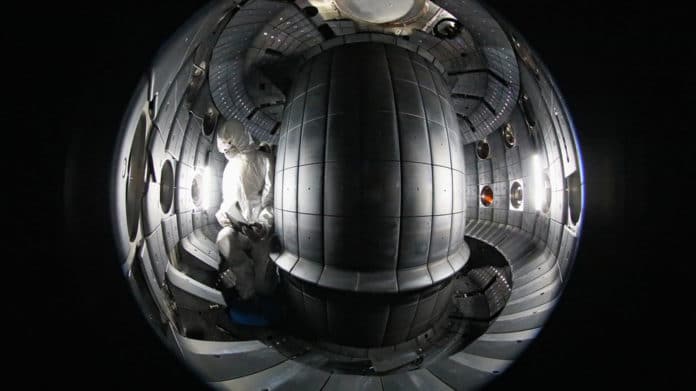Fusion power could potentially provide future generations with a nearly limitless energy source. Fusion, the nuclear reaction that powers the Sun and the stars, is a potential source of safe, non-carbon emitting, and virtually unlimited energy. A mega project called ITER aims to harness fusion power.
Fusion, the power that drives the Sun and stars, combines light elements in the form of plasma. Plasmas are created by subjecting hydrogen atoms to extremely high temperatures, forcing electrons to separate from their atomic nuclei. The overall process takes place within a donut-shaped (“toroidal”) structure called a “tokamak.”
Working within an extensive European collaboration, Paolo Ricci at the Swiss Plasma Center, one of the world’s leading research institutes in fusion located at EPFL, and his team released a study updating a foundational principle of plasma generation. Their study has shown that the upcoming ITER tokamak can operate with twice the amount of hydrogen and, therefore, generate more fusion energy.
Creating plasma requires three things to consider: high temperature, high density of hydrogen fuel, and good confinement. One of the limitations in making plasma inside a tokamak is the amount of hydrogen fuel you can inject into it.
In 1988, fusion scientist Martin Greenwald published a famous law that correlates fuel density to the tokamak’s minor radius and the current that flows within the Tokamak. Even the ITER’s tokamak-building strategy is based on what is known as Greenwald limit.
Ricci said, “Greenwald derived the law empirically, completely from experimental data – not a tested theory, or what we’d call ‘first principles.’ Still, the limit worked pretty well for research. And, in some cases, like DEMO (ITER’s successor), this equation constitutes a big limit to their operation because it says that you cannot increase fuel density above a certain level.”
Along with fellow tokamak teams, the Swiss Plasma Center designed an experiment where they could use highly sophisticated technology to precisely control the amount of fuel injected into a tokamak. They ran massive experiments at the world’s largest tokamaks, the Joint European Torus (JET) in the UK, the ASDEX Upgrade in Germany (Max Plank Institute), and EPFL’s own TCV tokamak.
The EUROfusion Consortium, a European organization that coordinates fusion research in Europe, made this tremendous experimental effort possible, and EPFL currently participates in it through the Max Planck Institute for Plasma Physics in Germany.
Simultaneously, Maurizio Giacomin, a Ph.D. student in Ricci’s group, started examining the physics processes limiting tokamaks’ density. The aim was to derive a first-principles law that can correlate fuel density and tokamak size. However, part of that entailed using a computer model to perform advanced plasma simulations.
Ricci said, “The simulations exploit some of the largest computers in the world, such as those made available by CSCS, the Swiss National Supercomputing Center, and by EUROfusion. And what we found, through our simulations, was that as you add more fuel into the plasma, parts of it move from the cold outer layer of the tokamak, the boundary, back into its core because the plasma becomes more turbulent. Then, unlike an electrical copper wire, which becomes more resistant when heated, plasmas become more resistant when they cool down. So, the more fuel you put into it at the same temperature, the more parts of it cool down – and the more difficult it is for current to flow in the plasma, possibly leading to disruption.”
“This was challenging to simulate. Turbulence in a fluid is the most important open issue in classical physics. But turbulence in plasma is even more complicated because you also have electromagnetic fields.”
Finally, Ricci and his colleagues cracked the code and put “pen to paper” to derive a new equation for the tokamak fuel limit closely matches experiments. The equation credits Greenwald’s limit by being near to it while significantly updating it.
The new equation posits that the Greenwald limit can be raised almost two-fold in terms of fuel in ITER; that means that tokamaks like ITER can use almost twice the amount of fuel to produce plasmas without worries of disruptions.
Ricci said, “This is important because it shows that the density you can achieve in a tokamak increases with the power you need to run it. DEMO will operate at a much higher power than present tokamaks and ITER, which means that you can add more fuel density without limiting the output, in contrast to the Greenwald law. And that is excellent news.”
Journal Reference:
- M. Giacomin et al. First-Principles Density Limit Scaling in Tokamaks Based on Edge Turbulent Transport and Implications for ITER. Physical Review Letters 128, 185003. DOI: 10.1103/PhysRevLett.128.185003
